Sentiment Analysis: A Definitive Guide

Sentiment analysis (or opinion mining) is a natural language processing (NLP) technique used to determine whether data is positive, negative or neutral. Sentiment analysis is often performed on textual data to help businesses monitor brand and product sentiment in customer feedback, and understand customer needs.
Start analyzing your text for sentiment
Learn more about how sentiment analysis works, its challenges, and how you can use sentiment analysis to improve processes, decision-making, customer satisfaction and more.
Once you’re familiar with the basics, get started with easy-to-use sentiment analysis tools that are ready to use right off the bat.
- What Is Sentiment Analysis?
- Types of Sentiment Analysis
- Why Is Sentiment Analysis Important?
- Sentiment Analysis Examples & Break Down of Trustpilot Reviews
- How Does Sentiment Analysis Work?
- Sentiment Analysis Challenges
- Sentiment Analysis Applications
- Sentiment Analysis Tools & Tutorials
- Sentiment Analysis Research & Courses
What Is Sentiment Analysis?

Sentiment analysis is the process of detecting positive or negative sentiment in text. It’s often used by businesses to detect sentiment in social data, gauge brand reputation, and understand customers.
Types of Sentiment Analysis
Sentiment analysis focuses on the polarity of a text (positive, negative, neutral) but it also goes beyond polarity to detect specific feelings and emotions (angry, happy, sad, etc), urgency (urgent, not urgent) and even intentions (interested v. not interested).
Depending on how you want to interpret customer feedback and queries, you can define and tailor your categories to meet your sentiment analysis needs. In the meantime, here are some of the most popular types of sentiment analysis:
Graded Sentiment Analysis
If polarity precision is important to your business, you might consider expanding your polarity categories to include different levels of positive and negative:
- Very positive
- Positive
- Neutral
- Negative
- Very negative
This is usually referred to as graded or fine-grained sentiment analysis, and could be used to interpret 5-star ratings in a review, for example:
- Very Positive = 5 stars
- Very Negative = 1 star
Emotion detection
Emotion detection sentiment analysis allows you to go beyond polarity to detect emotions, like happiness, frustration, anger, and sadness.
Many emotion detection systems use lexicons (i.e. lists of words and the emotions they convey) or complex machine learning algorithms.
One of the downsides of using lexicons is that people express emotions in different ways. Some words that typically express anger, like bad or kill (e.g. your product is so bad or your customer support is killing me) might also express happiness (e.g. this is bad ass or you are killing it).
Aspect-based Sentiment Analysis
Usually, when analyzing sentiments of texts you’ll want to know which particular aspects or features people are mentioning in a positive, neutral, or negative way.
That's where aspect-based sentiment analysis can help, for example in this product review: "The battery life of this camera is too short", an aspect-based classifier would be able to determine that the sentence expresses a negative opinion about the battery life of the product in question.
Multilingual sentiment analysis
Multilingual sentiment analysis can be difficult. It involves a lot of preprocessing and resources. Most of these resources are available online (e.g. sentiment lexicons), while others need to be created (e.g. translated corpora or noise detection algorithms), but you’ll need to know how to code to use them.
Alternatively, you could detect language in texts automatically with a language classifier, then train a custom sentiment analysis model to classify texts in the language of your choice.
Why Is Sentiment Analysis Important?
Since humans express their thoughts and feelings more openly than ever before, sentiment analysis is fast becoming an essential tool to monitor and understand sentiment in all types of data.
Automatically analyzing customer feedback, such as opinions in survey responses and social media conversations, allows brands to learn what makes customers happy or frustrated, so that they can tailor products and services to meet their customers’ needs.
For example, using sentiment analysis to automatically analyze 4,000+ open-ended responses in your customer satisfaction surveys could help you discover why customers are happy or unhappy at each stage of the customer journey.
Maybe you want to track brand sentiment so you can detect disgruntled customers immediately and respond as soon as possible. Maybe you want to compare sentiment from one quarter to the next to see if you need to take action. Then you could dig deeper into your qualitative data to see why sentiment is falling or rising.
The overall benefits of sentiment analysis include:
- Sorting Data at Scale
Can you imagine manually sorting through thousands of tweets, customer support conversations, or surveys? There’s just too much business data to process manually. Sentiment analysis helps businesses process huge amounts of unstructured data in an efficient and cost-effective way.
- Real-Time Analysis
Sentiment analysis can identify critical issues in real-time, for example is a PR crisis on social media escalating? Is an angry customer about to churn? Sentiment analysis models can help you immediately identify these kinds of situations, so you can take action right away.
- Consistent criteria
It’s estimated that people only agree around 60-65% of the time when determining the sentiment of a particular text. Tagging text by sentiment is highly subjective, influenced by personal experiences, thoughts, and beliefs.
By using a centralized sentiment analysis system, companies can apply the same criteria to all of their data, helping them improve accuracy and gain better insights.
The applications of sentiment analysis are endless. So, to help you understand how sentiment analysis could benefit your business, let’s take a look at some examples of texts that you could analyze using sentiment analysis.
Then, we’ll jump into a real-world example of how Chewy, a pet supplies company, was able to gain a much more nuanced (and useful!) understanding of their reviews through the application of sentiment analysis.
Sentiment Analysis Examples
To understand the goal and challenges of sentiment analysis, here are some examples:
Basic examples of sentiment analysis data
- Netflix has the best selection of films
- Hulu has a great UI
- I dislike like the new crime series
- I hate waiting for the next series to come out
More challenging examples of sentiment analysis
- I do not dislike horror movies. (phrase with negation)
- Disliking horror movies is not uncommon. (negation, inverted word order)
- Sometimes I really hate the show. (adverbial modifies the sentiment)
- I love having to wait two months for the next series to come out! ( sarcasm)
- The final episode was surprising with a terrible twist at the end (negative term used in a positive way)
- The film was easy to watch but I would not recommend it to my friends. (difficult to categorize)
- I LOL’d at the end of the cake scene (often hard to understand new terms)
Now, let’s take a look at some real reviews on Trustpilot and see how MonkeyLearn’s sentiment analysis tools fare when it comes to recognizing and categorizing sentiment.
Case Study: Sentiment analysis on TrustPilot Reviews
Chewy is a pet supplies company – an industry with no shortage of competition, so providing a superior customer experience (CX) to their customers can be a massive difference maker.
For this reason, online reviews can be an extremely valuable source of information to gain customer insights to improve their CX. Chewy has thousands of reviews in TrustPilot, this is what their review archive looks like:

Via TrustPilot
It is easy to draw a general conclusion about Chewy’s relative success from this alone - 82% of responses being excellent is a great starting place.
But TrustPilot’s results alone fall short if Chewy’s goal is to improve its services. This perfunctory overview fails to provide actionable insight, the cornerstone, and end goal, of effective sentiment analysis.
If Chewy wanted to unpack the what and why behind their reviews, in order to further improve their services, they would need to analyze each and every negative review at a granular level.
But with sentiment analysis tools, Chewy could plug in their 5,639 (at the time) TrustPilot reviews to gain instant sentiment analysis insights.
We uploaded and analyzed Chewy’s reviews to MonkeyLearn’s all-in-one data analysis and visualization studio to generate the following dashboard:
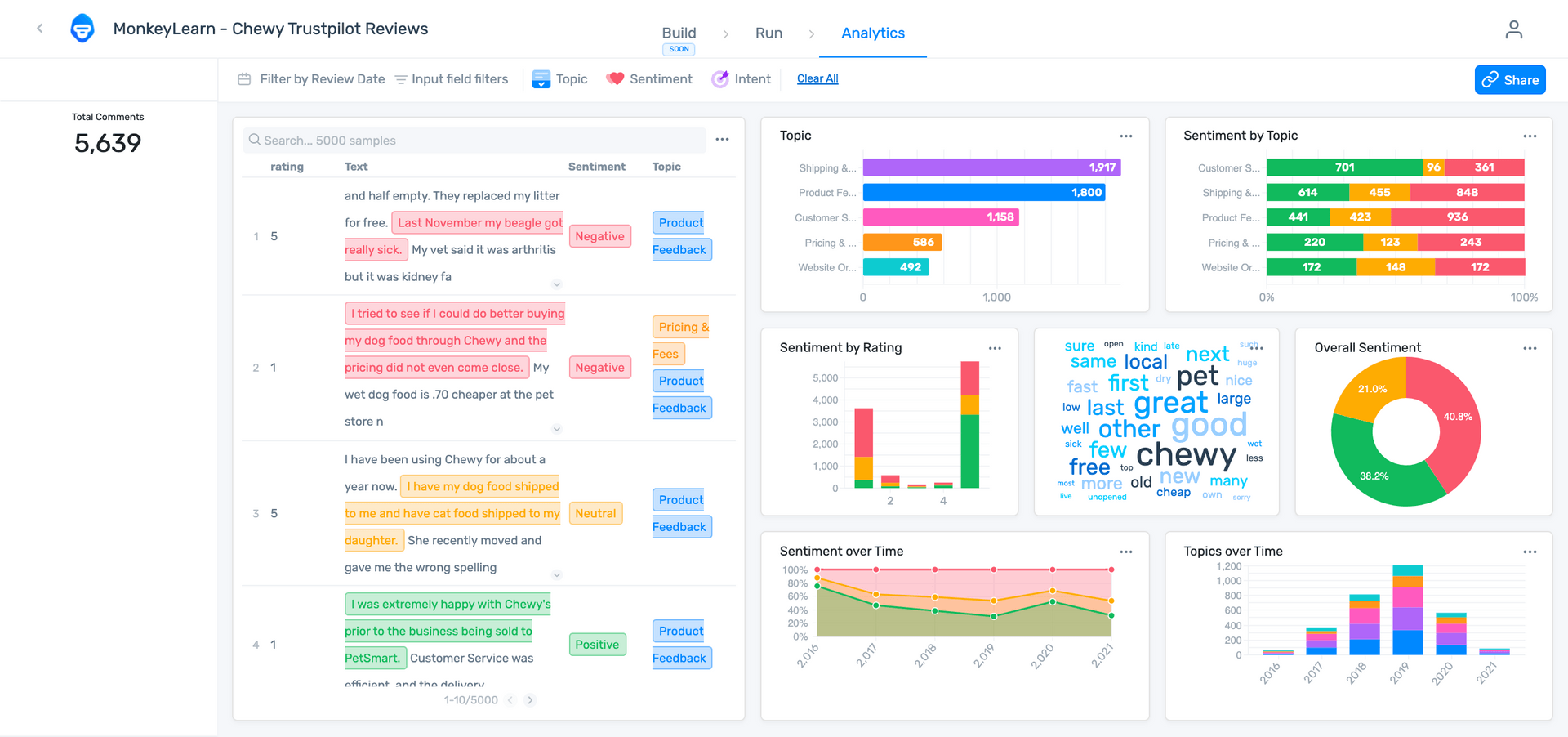
Chewy TrustPilot Reviews Sample
Feel free to click this link to peruse the results at your leisure - as this sample dashboard is a public demo, you can click through and explore the inputs and filters at work yourself.
While there is a ton more to explore, in this breakdown we are going to focus on four sentiment analysis data visualization results that the dashboard has visualized for us.
1. Overall sentiment
We’ll begin by pulling the relevant graphic from the above dashboard.
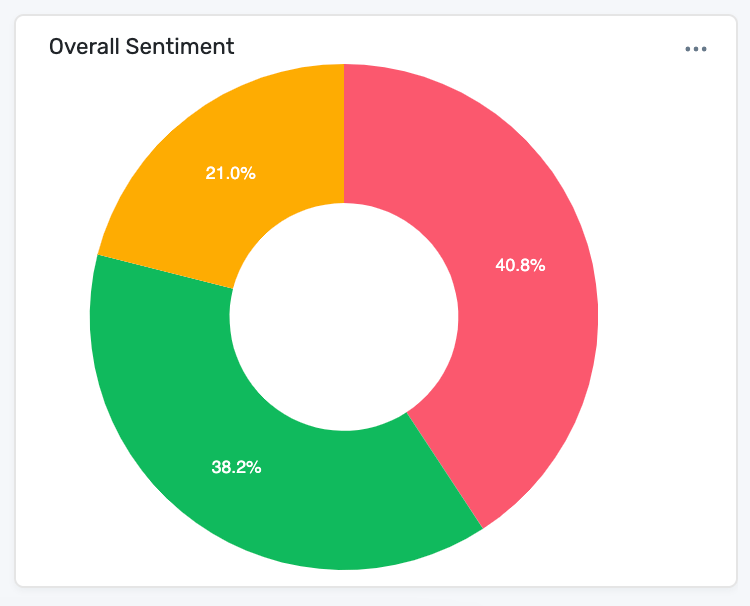
You’ll notice that these results are very different from TrustPilot’s overview (82% excellent, etc). This is because MonkeyLearn’s sentiment analysis AI performs advanced sentiment analysis, parsing through each review sentence by sentence, word by word.
What you are left with is an accurate assessment of everything customers have written, rather than a simple tabulation of stars. This analysis can point you towards friction points much more accurately and in much more detail.
Read up on the mechanics of how sentiment analysis works below.
2. Sentiment over time
Here’s our handy-dandy sentiment over time graph, blown up:

This data visualization sample is classic temporal datavis, a datavis type that tracks results and plots them over a period of time.
This graph expands on our Overall Sentiment data - it tracks the overall proportion of positive, neutral, and negative sentiment in the reviews from 2016 to 2021.
This graph informs the gradual change in the content of their written reviews over this five year period. For instance, negative responses went down from 2019-2020, then jumped back up to previous levels in 2021.
3. Sentiment by rating
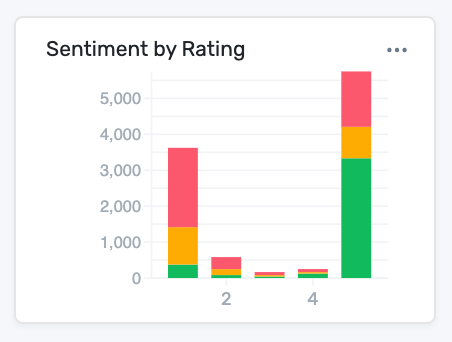
Now we jump to something that anchors our text-based sentiment to TrustPilot’s earlier results.
By taking each TrustPilot category from 1-Bad to 5-Excellent, and breaking down the text of the written reviews from the scores you can derive the above graphic.
Looking at the results, and courtesy of taking a deeper look at the reviews via sentiment analysis, we can draw a couple interesting conclusions right off the bat.
- TrustPilots results aren’t useless - the better reviews have higher proportions of positive sentiment and the worse reviews have more negative sentiment. But, all reviews contain a little bit of all types of sentiment - we’ve learned that our reviews are nuanced and thus likely have even more hidden insight for us!
- Our reviews are polarized. They skew in amounts towards 5 and 1.
These quick takeaways point us towards goldmines for future analysis. Namely, the positive sentiment sections of negative reviews and the negative section of positive ones, and the 2 - 4 reviews (why do they feel the way they do, how could we improve their scores?).
4. Sentiment by Topic
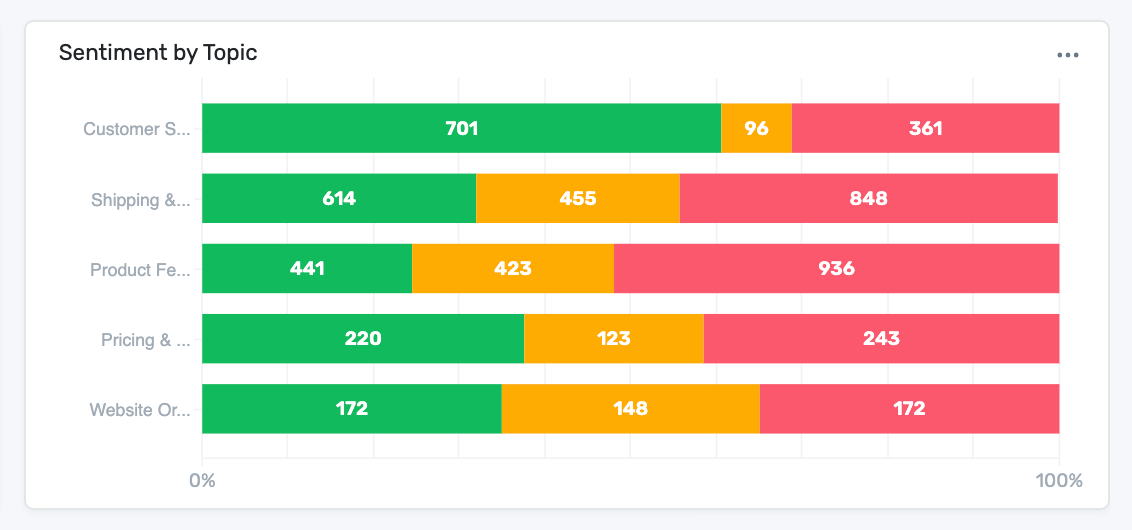
Finally, we can take a look at Sentiment by Topic to begin to illustrate how sentiment analysis can take us even further into our data.
The above chart applies product-linked text classification in addition to sentiment analysis to pair given sentiment to product/service specific features, this is known as aspect-based sentiment analysis.
This means we can know how our customers feel about what, helping us zero in and fix specific pain points or issues.
These are all great jumping off points designed to visually demonstrate the value of sentiment analysis - but they only scratch the surface of its true power.
Read on for a step-by-step walkthrough of how sentiment analysis works.
How Does Sentiment Analysis Work?
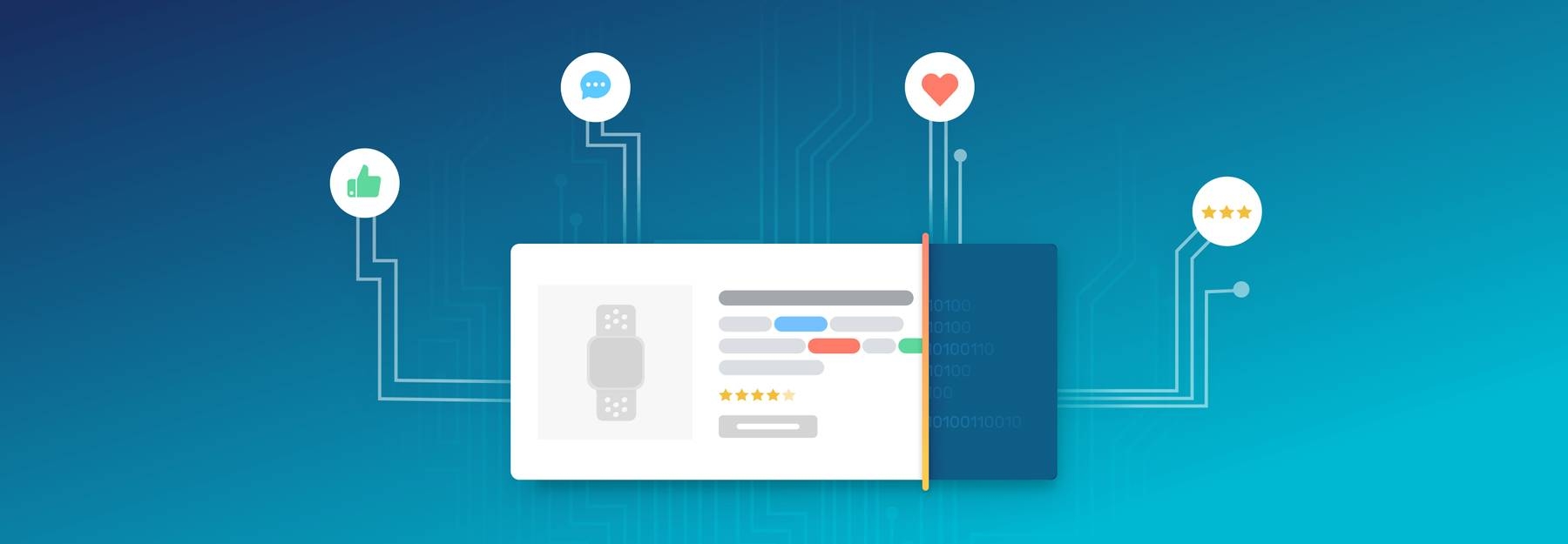
Sentiment analysis, otherwise known as opinion mining, works thanks to natural language processing (NLP) and machine learning algorithms, to automatically determine the emotional tone behind online conversations.
There are different algorithms you can implement in sentiment analysis models, depending on how much data you need to analyze, and how accurate you need your model to be. We’ll go over some of these in more detail, below.
Sentiment analysis algorithms fall into one of three buckets:
- Rule-based: these systems automatically perform sentiment analysis based on a set of manually crafted rules.
- Automatic: systems rely on machine learning techniques to learn from data.
- Hybrid systems combine both rule-based and automatic approaches.
Rule-based Approaches
Usually, a rule-based system uses a set of human-crafted rules to help identify subjectivity, polarity, or the subject of an opinion.
These rules may include various NLP techniques developed in computational linguistics, such as:
- Stemming, tokenization, part-of-speech tagging and parsing.
- Lexicons (i.e. lists of words and expressions).
Here’s a basic example of how a rule-based system works:
- Defines two lists of polarized words (e.g. negative words such as bad, worst, ugly, etc and positive words such as good, best, beautiful, etc).
- Counts the number of positive and negative words that appear in a given text.
- If the number of positive word appearances is greater than the number of negative word appearances, the system returns a positive sentiment, and vice versa. If the numbers are even, the system will return a neutral sentiment.
Rule-based systems are very naive since they don't take into account how words are combined in a sequence. Of course, more advanced processing techniques can be used, and new rules added to support new expressions and vocabulary. However, adding new rules may affect previous results, and the whole system can get very complex. Since rule-based systems often require fine-tuning and maintenance, they’ll also need regular investments.
Automatic Approaches
Automatic methods, contrary to rule-based systems, don't rely on manually crafted rules, but on machine learning techniques. A sentiment analysis task is usually modeled as a classification problem, whereby a classifier is fed a text and returns a category, e.g. positive, negative, or neutral.
Here’s how a machine learning classifier can be implemented:
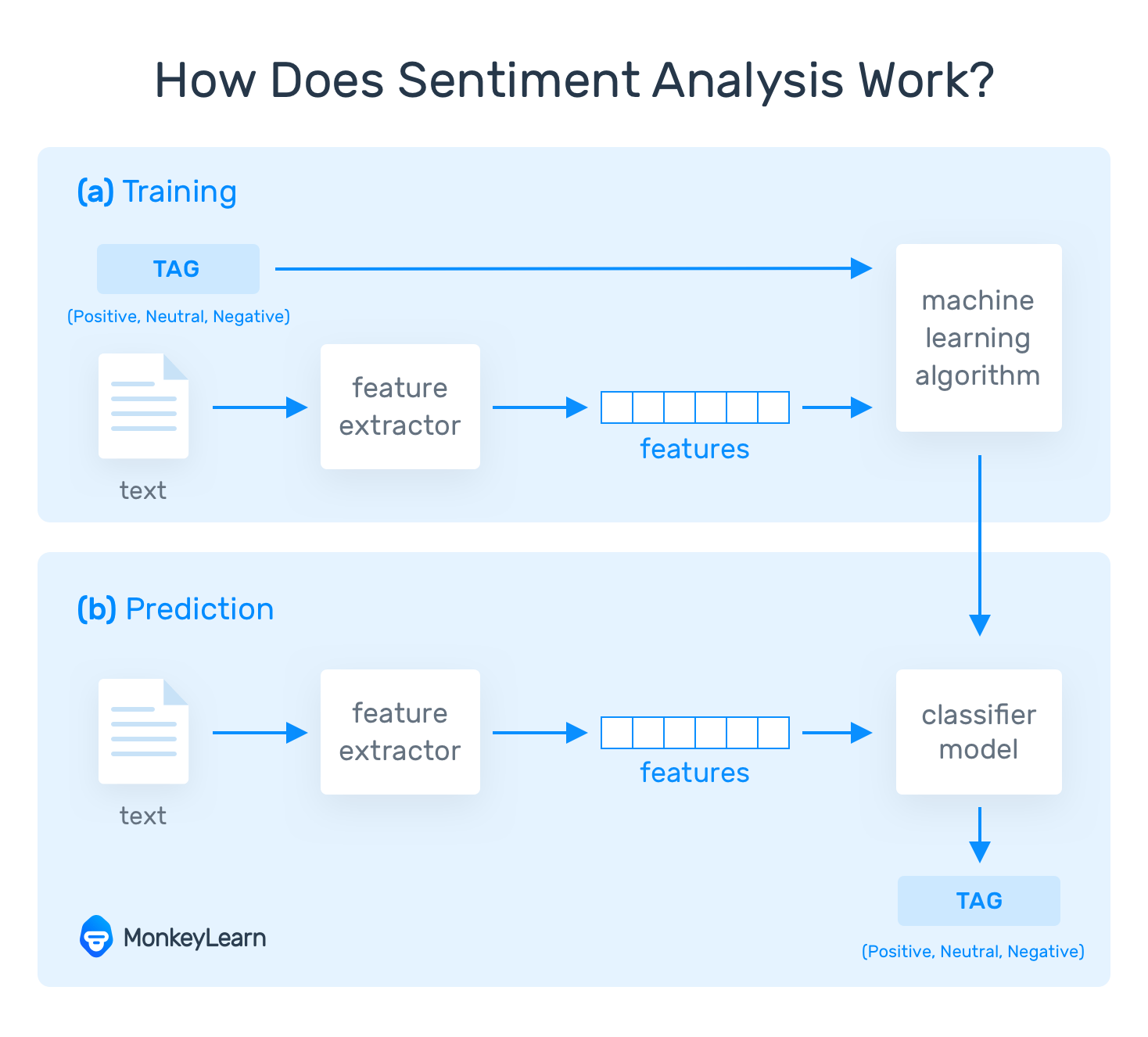
The Training and Prediction Processes
In the training process (a), our model learns to associate a particular input (i.e. a text) to the corresponding output (tag) based on the test samples used for training. The feature extractor transfers the text input into a feature vector. Pairs of feature vectors and tags (e.g. positive, negative, or neutral) are fed into the machine learning algorithm to generate a model.
In the prediction process (b), the feature extractor is used to transform unseen text inputs into feature vectors. These feature vectors are then fed into the model, which generates predicted tags (again, positive, negative, or neutral).
Feature Extraction from Text
The first step in a machine learning text classifier is to transform the text extraction or text vectorization, and the classical approach has been bag-of-words or bag-of-ngrams with their frequency.
More recently, new feature extraction techniques have been applied based on word embeddings (also known as word vectors). This kind of representations makes it possible for words with similar meaning to have a similar representation, which can improve the performance of classifiers.
Classification Algorithms
The classification step usually involves a statistical model like Naïve Bayes, Logistic Regression, Support Vector Machines, or Neural Networks:
- Naïve Bayes: a family of probabilistic algorithms that uses Bayes’s Theorem to predict the category of a text.
- Linear Regression: a very well-known algorithm in statistics used to predict some value (Y) given a set of features (X).
- Support Vector Machines: a non-probabilistic model which uses a representation of text examples as points in a multidimensional space. Examples of different categories (sentiments) are mapped to distinct regions within that space. Then, new texts are assigned a category based on similarities with existing texts and the regions they’re mapped to.
- Deep Learning: a diverse set of algorithms that attempt to mimic the human brain, by employing artificial neural networks to process data.
Hybrid Approaches
Hybrid systems combine the desirable elements of rule-based and automatic techniques into one system. One huge benefit of these systems is that results are often more accurate.
Sentiment Analysis Challenges
Sentiment analysis is one of the hardest tasks in natural language processing because even humans struggle to analyze sentiments accurately.
Data scientists are getting better at creating more accurate sentiment classifiers, but there’s still a long way to go. Let’s take a closer look at some of the main challenges of machine-based sentiment analysis:
- Subjectivity & Tone
- Context & Polarity
- Irony & Sarcasm
- Comparisons
- Emojis
- Defining Neutral
- Human Annotator Accuracy
Subjectivity and Tone
There are two types of text: subjective and objective. Objective texts do not contain explicit sentiments, whereas subjective texts do. Say, for example, you intend to analyze the sentiment of the following two texts:
The package is nice.
The package is red.
Most people would say that sentiment is positive for the first one and neutral for the second one, right? All predicates (adjectives, verbs, and some nouns) should not be treated the same with respect to how they create sentiment. In the examples above, nice is more subjective than red.
Context and Polarity
All utterances are uttered at some point in time, in some place, by and to some people, you get the point. All utterances are uttered in context. Analyzing sentiment without context gets pretty difficult. However, machines cannot learn about contexts if they are not mentioned explicitly. One of the problems that arise from context is changes in polarity. Look at the following responses to a survey:
Everything about it.
Absolutely nothing!
Imagine the responses above come from answers to the question What did you like about the event? The first response would be positive and the second one would be negative, right? Now, imagine the responses come from answers to the question What did you DISlike about the event? The negative in the question will make sentiment analysis change altogether.
A good deal of preprocessing or postprocessing will be needed if we are to take into account at least part of the context in which texts were produced. However, how to preprocess or postprocess data in order to capture the bits of context that will help analyze sentiment is not straightforward.
Irony and Sarcasm
When it comes to irony and sarcasm, people express their negative sentiments using positive words, which can be difficult for machines to detect without having a thorough understanding of the context of the situation in which a feeling was expressed.
For example, look at some possible answers to the question, Did you enjoy your shopping experience with us?
Yeah, sure. So smooth!
Not one, but many!
What sentiment would you assign to the responses above? The first response with an exclamation mark could be negative, right? The problem is there is no textual cue that will help a machine learn, or at least question that sentiment since yeah and sure often belong to positive or neutral texts.
How about the second response? In this context, sentiment is positive, but we’re sure you can come up with many different contexts in which the same response can express negative sentiment.
Comparisons
How to treat comparisons in sentiment analysis is another challenge worth tackling. Look at the texts below:
This product is second to none.
This is better than older tools.
This is better than nothing.
The first comparison doesn’t need any contextual clues to be classified correctly. It’s clear that it’s positive.
The second and third texts are a little more difficult to classify, though. Would you classify them as neutral, positive, or even negative? Once again, context can make a difference. For example, if the ‘older tools’ in the second text were considered useless, then the second text is pretty similar to the third text.
Emojis
There are two types of emojis according to Guibon et al.. Western emojis (e.g. :D) are encoded in only one or two characters, whereas Eastern emojis (e.g. ¯ \ (ツ) / ¯) are a longer combination of characters of a vertical nature. Emojis play an important role in the sentiment of texts, particularly in tweets.
You’ll need to pay special attention to character-level, as well as word-level, when performing sentiment analysis on tweets. A lot of preprocessing might also be needed. For example, you might want to preprocess social media content and transform both Western and Eastern emojis into tokens and whitelist them (i.e. always take them as a feature for classification purposes) in order to help improve sentiment analysis performance.
Here’s a quite comprehensive list of emojis and their unicode characters that may come in handy when preprocessing.
Defining Neutral
Defining what we mean by neutral is another challenge to tackle in order to perform accurate sentiment analysis. As in all classification problems, defining your categories -and, in this case, the neutral tag- is one of the most important parts of the problem. What you mean by neutral, positive, or negative does matter when you train sentiment analysis models. Since tagging data requires that tagging criteria be consistent, a good definition of the problem is a must.
Here are some ideas to help you identify and define neutral texts:
- Objective texts. So called objective texts do not contain explicit sentiments, so you should include those texts into the neutral category.
- Irrelevant information. If you haven’t preprocessed your data to filter out irrelevant information, you can tag it neutral. However, be careful! Only do this if you know how this could affect overall performance. Sometimes, you will be adding noise to your classifier and performance could get worse.
- Texts containing wishes. Some wishes like, I wish the product had more integrations are generally neutral. However, those including comparisons like, I wish the product were better are pretty difficult to categorize
Human Annotator Accuracy
Sentiment analysis is a tremendously difficult task even for humans. On average, inter-annotator agreement (a measure of how well two (or more) human labelers can make the same annotation decision) is pretty low when it comes to sentiment analysis. And since machines learn from labeled data, sentiment analysis classifiers might not be as precise as other types of classifiers.
Still, sentiment analysis is worth the effort, even if your sentiment analysis predictions are wrong from time to time. By using MonkeyLearn’s sentiment analysis model, you can expect correct predictions about 70-80% of the time you submit your texts for classification.
If you are new to sentiment analysis, then you’ll quickly notice improvements. For typical use cases, such as ticket routing, brand monitoring, and VoC analysis, you’ll save a lot of time and money on tedious manual tasks.
Sentiment Analysis Use Cases & Applications

The applications of sentiment analysis are endless and can be applied to any industry, from finance and retail to hospitality and technology. Below, we’ve listed some of the most popular ways that sentiment analysis is being used in business:
Social Media Monitoring
Sentiment analysis is used in social media monitoring, allowing businesses to gain insights about how customers feel about certain topics, and detect urgent issues in real time before they spiral out of control.
On the fateful evening of April 9th, 2017, United Airlines forcibly removed a passenger from an overbooked flight. The nightmare-ish incident was filmed by other passengers on their smartphones and posted immediately. One of the videos, posted to Facebook, was shared more than 87,000 times and viewed 6.8 million times by 6pm on Monday, just 24 hours later.
The fiasco was only magnified by the company’s dismissive response. On Monday afternoon, United’s CEO tweeted a statement apologizing for “having to re-accommodate customers.”
This is exactly the kind of PR catastrophe you can avoid with sentiment analysis. It’s an example of why it’s important to care, not only about if people are talking about your brand, but how they’re talking about it. More mentions don't equal positive mentions.
Brands of all shapes and sizes have meaningful interactions with customers, leads, even their competition, all across social media. By monitoring these conversations you can understand customer sentiment in real time and over time, so you can detect disgruntled customers immediately and respond as soon as possible.
Most marketing departments are already tuned into online mentions as far as volume – they measure more chatter as more brand awareness. But businesses need to look beyond the numbers for deeper insights.
Brand Monitoring
Not only do brands have a wealth of information available on social media, but across the internet, on news sites, blogs, forums, product reviews, and more. Again, we can look at not just the volume of mentions, but the individual and overall quality of those mentions.
In our United Airlines example, for instance, the flare-up started on the social media accounts of just a few passengers. Within hours, it was picked up by news sites and spread like wildfire across the US, then to China and Vietnam, as United was accused of racial profiling against a passenger of Chinese-Vietnamese descent. In China, the incident became the number one trending topic on Weibo, a microblogging site with almost 500 million users.
And again, this is all happening within mere hours of the incident.
Brand monitoring offers a wealth of insights from conversations happening about your brand from all over the internet. Analyze news articles, blogs, forums, and more to gauge brand sentiment, and target certain demographics or regions, as desired. Automatically categorize the urgency of all brand mentions and route them instantly to designated team members.
Get an understanding of customer feelings and opinions, beyond mere numbers and statistics. Understand how your brand image evolves over time, and compare it to that of your competition. You can tune into a specific point in time to follow product releases, marketing campaigns, IPO filings, etc., and compare them to past events.
Real-time sentiment analysis allows you to identify potential PR crises and take immediate action before they become serious issues. Or identify positive comments and respond directly, to use them to your benefit.
Example: Expedia Canada
Around Christmas time, Expedia Canada ran a classic “escape winter” marketing campaign. All was well, except for the screeching violin they chose as background music. Understandably, people took to social media, blogs, and forums. Expedia noticed right away and removed the ad.
Then, they created a series of follow-up spin-off videos: one showed the original actor smashing the violin; another invited a real negative Twitter user to rip the violin out of the actor’s hands on screen. Though their original campaign was a flop, Expedia were able to redeem themselves by listening to their customers and responding.
Sentiment analysis allows you to automatically monitor all chatter around your brand and detect and address this type of potentially-explosive scenario while you still have time to defuse it.
Voice of Customer (VoC)
Social media and brand monitoring offer us immediate, unfiltered, and invaluable information on customer sentiment, but you can also put this analysis to work on surveys and customer support interactions.
Net Promoter Score (NPS) surveys are one of the most popular ways for businesses to gain feedback with the simple question: Would you recommend this company, product, and/or service to a friend or family member? These result in a single score on a number scale.
Businesses use these scores to identify customers as promoters, passives, or detractors. The goal is to identify overall customer experience, and find ways to elevate all customers to “promoter” level, where they, theoretically, will buy more, stay longer, and refer other customers.
Numerical (quantitative) survey data is easily aggregated and assessed. But the next question in NPS surveys, asking why survey participants left the score they did, seeks open-ended responses, or qualitative data.
Open-ended survey responses were previously much more difficult to analyze, but with sentiment analysis these texts can be classified into positive and negative (and everywhere in between) offering further insights into the Voice of Customer (VoC).
Sentiment analysis can be used on any kind of survey – quantitative and qualitative – and on customer support interactions, to understand the emotions and opinions of your customers. Tracking customer sentiment over time adds depth to help understand why NPS scores or sentiment toward individual aspects of your business may have changed.
You can use it on incoming surveys and support tickets to detect customers who are ‘strongly negative’ and target them immediately to improve their service. Zero in on certain demographics to understand what works best and how you can improve.
Real-time analysis allows you to see shifts in VoC right away and understand the nuances of the customer experience over time beyond statistics and percentages.
Discover how we analyzed the sentiment of thousands of Facebook reviews, and transformed them into actionable insights.
Example: McKinsey City Voices project
In Brazil, federal public spending rose by 156% from 2007 to 2015, while satisfaction with public services steadily decreased. Unhappy with this counterproductive progress, the Urban Planning Department recruited McKinsey to help them focus on user experience, or “citizen journeys,” when delivering services. This citizen-centric style of governance has led to the rise of what we call Smart Cities.
McKinsey developed a tool called City Voices, which conducts citizen surveys across more than 150 metrics, and then runs sentiment analysis to help leaders understand how constituents live and what they need, in order to better inform public policy. By using this tool, the Brazilian government was able to uncover the most urgent needs – a safer bus system, for instance – and improve them first.
If this can be successful on a national scale, imagine what it can do for your company.
Customer Service
We already looked at how we can use sentiment analysis in terms of the broader VoC, so now we’ll dial in on customer service teams.
We all know the drill: stellar customer experiences means a higher rate of returning customers. Leading companies know that how they deliver is just as, if not more, important as what they deliver. Customers expect their experience with companies to be immediate, intuitive, personal, and hassle-free. If not, they’ll leave and do business elsewhere. Did you know that one in three customers will leave a brand after just one bad experience?
You can use sentiment analysis and text classification to automatically organize incoming support queries by topic and urgency to route them to the correct department and make sure the most urgent are handled right away.
Analyze customer support interactions to ensure your employees are following appropriate protocol. Increase efficiency, so customers aren’t left waiting for support. Decrease churn rates; after all it’s less hassle to keep customers than acquire new ones.
Discover how we analyzed customer support interactions on Twitter.
Market Research
Sentiment analysis empowers all kinds of market research and competitive analysis. Whether you’re exploring a new market, anticipating future trends, or seeking an edge on the competition, sentiment analysis can make all the difference.
You can analyze online reviews of your products and compare them to your competition. Maybe your competitor released a new product that landed as a flop. Find out what aspects of the product performed most negatively and use it to your advantage.
Follow your brand and your competition in real time on social media. Locate new markets where your brand is likely to succeed. Uncover trends just as they emerge, or follow long-term market leanings through analysis of formal market reports and business journals.
You’ll tap into new sources of information and be able to quantify otherwise qualitative information. With social data analysis you can fill in gaps where public data is scarce, like emerging markets.
Discover how to analyze the sentiment of hotel reviews on TripAdvisor or perform sentiment analysis on Yelp restaurant reviews.
Sentiment Analysis Tools & Tutorials

Sentiment analysis is a vast topic, and it can be intimidating to get started. Luckily, there are many useful resources, from helpful tutorials to all kinds of free online tools, to help you take your first steps.
Free Online Sentiment Analysis Tools
A good start to your journey is to simply play around with a sentiment analysis tool. A little first-hand experience will help you understand how it works
Next, to take your sentiment analysis further, you’ll want to try out MonkeyLearn’s sentiment analysis and keyword template. First, you’ll need sign up, then walk through the following steps:
1. Choose Keyword + Sentiment Analysis template

2. Upload your data

If you don't have a CSV, you can use our sample dataset.
3. Match the CSV columns to the dashboard fields
In this template, there is only one field: text. If you have more than one column in your dataset, choose the column that has the text you would like to analyze.

4. Name your workflow

5. Wait for your data to import

6. Explore your dashboard!

You can:
- Filter by sentiment or keyword.
- Share via email with other coworkers.
Open Source vs SaaS (Software as a Service) Sentiment Analysis Tools
When it comes to sentiment analysis (and text analysis in general), you have two choices: build your own solution or buy a tool.
Open source libraries in languages like Python and Java are particularly well positioned to build your own sentiment analysis solution because their communities lean more heavily toward data science, like natural language processing and deep learning for sentiment analysis. But you’ll need a team of data scientists and engineers on board, huge upfront investments, and time to spare.
SaaS tools offer the option to implement pre-trained sentiment analysis models immediately or custom-train your own, often in just a few steps. These tools are recommended if you don’t have a data science or engineering team on board, since they can be implemented with little or no code and can save months of work and money (upwards of $100,000).
Another key advantage of SaaS tools is that you don't even need to know how to code; they provide integrations with third-party apps, like MonkeyLearn’s Zendesk, Excel and Zapier Integrations.
If you want to get started with these out-of-the-box tools, check out this guide to the best SaaS tools for sentiment analysis, which also come with APIs for seamless integration with your existing tools.
Or start learning how to perform sentiment analysis using MonkeyLearn’s API and the pre-built sentiment analysis model, with just six lines of code. Then, train your own custom sentiment analysis model using MonkeyLearn’s easy-to-use UI.
If you’re still convinced that you need to build your own sentiment analysis solution, check out these tools and tutorials in various programming languages:
Sentiment Analysis Python
- Scikit-learn is the go-to library for machine learning and has useful tools for text vectorization. Training a classifier on top of vectorizations, like frequency or tf-idf text vectorizers is quite straightforward. Scikit-learn has implementations for Support Vector Machines, Naïve Bayes, and Logistic Regression, among others.
- NLTK has been the traditional NLP library for Python. It has an active community and offers the possibility to train machine learning classifiers.
- SpaCy is an NLP library with a growing community. Like NLTK, it provides a strong set of low-level functions for NLP and support for training text classifiers.
- TensorFlow, developed by Google, provides a low-level set of tools to build and train neural networks. There's also support for text vectorization, both on traditional word frequency and on more advanced through-word embeddings.
- Keras provides useful abstractions to work with multiple neural network types, like recurrent neural networks (RNNs) and convolutional neural networks (CNNs) and easily stack layers of neurons. Keras can be run on top of Tensorflow or Theano. It also provides useful tools for text classification.
- PyTorch is a recent deep learning framework backed by some prestigious organizations like Facebook, Twitter, Nvidia, Salesforce, Stanford University, University of Oxford, and Uber. It has quickly developed a strong community.
Tutorials to try out:
Python web scraping and sentiment analysis: this tutorial provides a step-by-step guide on how to analyze the top 100 subreddits by sentiment. It explains how to use Beautiful Soup, one of the most popular Python libraries for web scraping that collects the names of the top subreddit web pages (subreddits like /r/funny, /r/AskReddit and /r/todayilearned).
Using Praw library, it demonstrates how to interact with the Reddit API and extract the comments from these subreddits. Then, learn how to use TextBlob to perform sentiment analysis on the extracted comments. Code: https://github.com/jg-fisher/redditSentiment
Twitter sentiment analysis using Python and NLTK: This step-by-step guide shows you how to train your first sentiment classifier. The author uses Natural Language Toolkit NLTK to train a classifier on tweets. Making Sentiment Analysis Easy with Scikit-learn: This tutorial explains how to train a logistic regression model for sentiment analysis.
Making Sentiment Analysis Easy with Scikit-learn: This tutorial explains how to train a logistic regression model for sentiment analysis.
Sentiment Analysis Javascript
Java is another programming language with a strong community around data science with remarkable data science libraries for NLP.
- OpenNLP: a toolkit that supports the most common NLP tasks, such as tokenization, sentence segmentation, part-of-speech tagging, named entity extraction, chunking, parsing, language detection and coreference resolution.
- Stanford CoreNLP: a Java suite of core NLP tools provided by The Stanford NLP Group.
- Lingpipe: a Java toolkit for processing text using computational linguistics. LingPipe is often used for text classification and entity extraction.
- Weka: a set of tools created by The University of Waikato for data pre-processing, classification, regression, clustering, association rules, and visualization.
Sentiment Analysis Research & Courses

After learning the basics of sentiment analysis, and understanding how it can help you, you might want to delve further into the topic:
Sentiment Analysis Papers
The literature around sentiment analysis is massive; there are more than 55,700 scholarly articles, papers, theses, books, and abstracts out there.
The following are the most frequently cited and read papers in the sentiment analysis community in general:
- Opinion mining and sentiment analysis (Pang and Lee, 2008)
- Recognizing contextual polarity in phrase-level sentiment analysis (Wilson, Wiebe and Hoffmann, 2005).
- A survey of opinion mining and sentiment analysis (Liu and Zhang, 2012)
- Sentiment analysis and opinion mining (Liu, 2012)
- How to Perform Text Mining with Sentiment Analysis
Sentiment Analysis Books
Bing Liu is a thought leader in the field of machine learning and has written a book about sentiment analysis and opinion mining.
Useful for those starting research on sentiment analysis, Liu does a wonderful job of explaining sentiment analysis in a way that is highly technical, yet understandable. In the book, he covers different aspects of sentiment analysis including applications, research, sentiment classification using supervised and unsupervised learning, sentence subjectivity, aspect-based sentiment analysis, and more.
For those who want to learn about deep-learning based approaches for sentiment analysis, a relatively new and fast-growing research area, take a look at Deep-Learning Based Approaches for Sentiment Analysis.
Sentiment Analysis Courses and Lectures
Another good way to go deeper with sentiment analysis is mastering your knowledge and skills in natural language processing (NLP), the computer science field that focuses on understanding ‘human’ language.
By combining machine learning, computational linguistics, and computer science, NLP allows a machine to understand natural language including people's sentiments, evaluations, attitudes, and emotions from written language.
There are a large number of courses, lectures, and resources available online, but the essential NLP course is the Stanford Coursera course by Dan Jurafsky and Christopher Manning. By taking this course, you will get a step-by-step introduction to the field by two of the most reputable names in the NLP community.
If you want a more hands-on course, you should enroll in the Data Science: Natural Language Processing (NLP) in Python on Udemy. This course gives you a good introduction to NLP and what it can do, but it will also make you build different projects in Python, including a spam detector, a sentiment analyzer, and an article spinner. Most of the lectures are really short (~5 minutes) and the course strikes the right balance between practical and theoretical content.
Sentiment Analysis Datasets
The key part for mastering sentiment analysis is working on different datasets and experimenting with different approaches. First, you’ll need to get your hands on data and procure a dataset which you will use to carry out your experiments.
The following are some of our favorite sentiment analysis datasets for experimenting with sentiment analysis and a machine learning approach. They’re open and free to download:
- Product reviews: this dataset consists of a few million Amazon customer reviews with star ratings, super useful for training a sentiment analysis model.
- Restaurant reviews: this dataset consists of 5,2 million Yelp reviews with star ratings.
- Movie reviews: this dataset consists of 1,000 positive and 1,000 negative processed reviews. It also provides 5,331 positive and 5,331 negative processed sentences / snippets.
- Fine food reviews: this dataset consists of ~500,000 food reviews from Amazon. It includes product and user information, ratings, and a plain text version of every review.
- Twitter airline sentiment on Kaggle: this dataset consists of ~15,000 labeled tweets (positive, neutral, and negative) about airlines.
- First GOP Debate Twitter Sentiment: this dataset consists of ~14,000 labeled tweets (positive, neutral, and negative) about the first GOP debate in 2016.
If you are interested in rule-based approach, the following is a varied list of sentiment analysis lexicons that will come in handy. These lexicons provide a set of dictionaries of words with labels specifying their sentiments across different domains. The following lexicons are really useful to identify the sentiment of texts:
- Sentiment Lexicons for 81 Languages: this dataset contains both positive and negative sentiment lexicons for 81 languages.
- SentiWordNet: this dataset contains about 29,000 words with a sentiment score between 0 and 1.
- Opinion Lexicon for Sentiment Analysis: this dataset provides a list of 4,782 negative words and 2,005 positive words in English.
- Wordstat Sentiment Dictionary: this dataset includes ~4800 positive and ~9000 negative words.
- Emoticon Sentiment Lexicon: this dataset contains a list of 477 emoticons labeled as positive, neutral, or negative.
Parting words
Sentiment analysis can be applied to countless aspects of business, from brand monitoring and product analytics, to customer service and market research. By incorporating it into their existing systems and analytics, leading brands (not to mention entire cities) are able to work faster, with more accuracy, toward more useful ends.
Sentiment analysis has moved beyond merely an interesting, high-tech whim, and will soon become an indispensable tool for all companies of the modern age. Ultimately, sentiment analysis enables us to glean new insights, better understand our customers, and empower our own teams more effectively so that they do better and more productive work.
MonkeyLearn is an online platform that makes it easy to perform text analytics with machine learning and data visualization tools.
If you need help building a sentiment analysis system for your business, visit MonkeyLearn Studio and request a demo.



